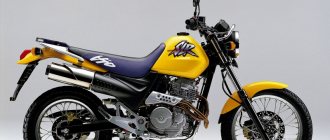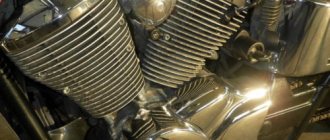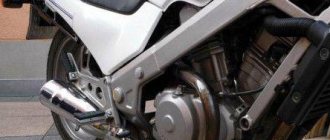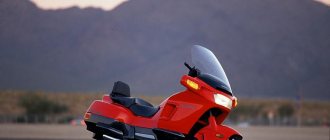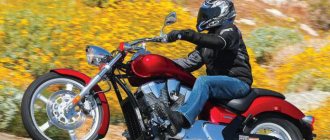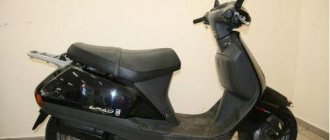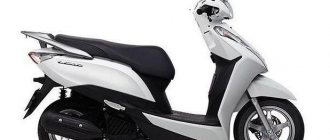The Honda CBR 250 motorcycle is one of the best “devices” created by Honda in the 250 cc category. This lightweight sports motorcycle, which has a 6-speed gearbox and is capable of producing 45 horsepower, will not leave all sports class fans indifferent.
Every year this model was subject to changes. In 1988, instead of one large headlight, two small twin headlights were installed, the chain was reduced in size, and the fuel pump also underwent changes.
In 1989, the speed limiter on the motorcycle was set at 185 kilometers per hour.
In 1990-1991, the Honda CBR 250 R motorcycle received a new design that almost completely changed its appearance (a new, more aggressive aluminum frame and a swingarm borrowed from the NSR 250 R model). The motorcycle also received double 276 mm. front brake discs and underwent changes to the fuel system.
Initially, the new models were sold only in Japan; later the Honda CBR 250 R appeared in Australia. At the moment, this motorcycle can be found in many countries, including Russia.
000_moto_0211_056
Honda CBR250R: Roadster, 2011, 249.4 cc, 26.2 hp, 165 kg.
Honda CBR250R: Roadster, 2011, 249.4 cc, 26.2 hp, 165 kg.
At the same time, the “chekushka” supplemented the “bottom” range of Honda roadsters - the company’s second Main Breadbasket in the old-world markets, and - most importantly - headed the extensive family of “utilities” in the Asian markets.
Just don’t mock the letters R in the name, deciphering them in a new way! Indeed, this combination of power and weight is more consistent with the good old Jawa 350 or a large-wheeled utilitarian scooter; for example, Honda's SH300. But the SH300 in Europe is offered for 4,500 euros, and the new CBR250R will cost half a thousand less than the “luxury string bag” - and this is already the territory of more modest devices. Let's say the Aprilia Sportcity 300, which weighs almost the same but has 22.4 horsepower.
And the approach to design here is similar to Sportcity: behind the cladding a la sport is a simple, but without primitive, “filling”. Moreover, unlike some competitors, it is entirely and completely modern in design. The frame is open tubular, but its shape hints that the development was carried out in an era when strength and rigidity can be calculated, and not estimated by eye. The suspensions are the simplest, but the Japanese considered it inappropriate to abandon the “progressive” rear (previously they easily did this for liter roadsters, but here they decided that comfort was more important). And the brakes may not be the most “advanced,” but they do have ABS, albeit optional.
The engine was developed in a similar vein. With a wet (and not dry, like enduro engines, and not semi-dry, like the CRF or the same SH300) crankcase, four-valve and two-shaft. But - with roller pushers to reduce losses, and the twisting of the channels, although purely “civilian”, still implies a certain potential for forcing. This is also indicated by the throttle diameter: 38 mm (for the 27-horsepower and 280 cc SH300 - 34). And the low end is well supported by a long, tapered intake pipe, most of which extends deep into the airbox. One more point: the main crankshaft supports are on liners, and the toe support, located in the cover, as well as the balancer shaft and pump supports, are on ball bearings. I see this scheme as optimal in terms of “survivability-repairability” ratio.
The latter is also useful in affluent Europe, the USA and Japan, where a motorcycle is intended to become both an alternative to a scooter - which means it can often be started “cold” - and a simulator for beginners, regularly changing their not very competent and thrifty owners. And this is especially true in the main Asian markets, where the CBR250R will be “premium” by local standards, but still a workhorse, mercilessly driven by its not the most technically competent owners. And all these above-mentioned comrades will appreciate... no, not the style, but the ego-flattering external resemblance to “full-size” Honda motorcycles. And the design is not extravagant (no need to scare the average person!), but modern in every detail, from the wheels to the dashboard. Not a single hello from the time when the most decrepit of the current second-hand stores were the new items of the season.
And that there will be one version, without any “nudity” or “intersection” there, is both logical (it looks richer and hides the cheap “filling”) and technologically. And the chosen production location (like that of the Main Competitor - Thailand plus assembly for local markets in India and, possibly, Brazil) is both budgetary and logistical.
New motorcycle Honda CBR 250 R
The new Honda CBR 250 R met all the expectations of motorcyclists. This motorcycle has been designed using the latest technology, including a new fuel injection system.
The engine of the CBR 250 R motorcycle, unlike its predecessor (without the letter R), is low-speed and has only one cylinder, which is capable of spinning the crankshaft up to 10.5 thousand revolutions per minute.
The light weight of the motorcycle, the smoothly functioning 6-speed gearbox, and stability at high speed make this motorcycle one of the best in the line of 250 cc motorcycles .
This motorcycle is assembled in Thailand, and can be found on sale all over the world.
The new 2011 model is a reliable, stylish, and most importantly affordable motorcycle, made in a modern style.
For lovers of Honda , we advise you to take a look at the younger model (125 cubic centimeters) in the CBR family called the Honda CBR 125, which strives to keep up with its older brothers.
006_moto_0211_056
The only key market where the CBR250 is not yet introduced is South America.
For him, the Brazilian branch of Honda has been producing the CB300R roadster since the summer of 2009. Its 26.5-horsepower engine is largely similar to the CBR250 unit, but differs in air-oil cooling and increased displacement. And the chassis is much simpler: with a half-duplex frame, a rear drum brake and no “progression” in the rear suspension - but also with optional ABS. The only key market where the CBR250 is not yet introduced is South America. For him, the Brazilian branch of Honda has been producing the CB300R roadster since the summer of 2009. Its 26.5-horsepower engine is largely similar to the CBR250 unit, but differs in air-oil cooling and increased displacement. And the chassis is much simpler: with a half-duplex frame, a rear drum brake and no “progression” in the rear suspension - but also with optional ABS.
Technical characteristics of Honda CBR250R (manufacturer data)
| COMMON DATA | |
| Model year | 2011 |
| Curb weight, kg | 165 |
| Length × width × height, mm | 2030×709,5×1127 |
| Wheelbase, mm | 1369 |
| Ground clearance, mm | 148 |
| Seat height, mm | 784 |
| Reach, mm | 95 |
| Steering column tilt angle, degrees. | 25 |
| Gas tank volume, l | 13 |
| ENGINE | |
| Type | 1-cyl., 4T |
| timing belt | DOHC, 4 valves per cylinder |
| Working volume, cm³ | 249,4 |
| Dimension, mm | 76×55 |
| Compression ratio | 10,7:1 |
| Supply system | fuel injection, 38 mm |
| Cooling system | liquid |
| Starting system | electric starter |
| Max. power, hp at rpm | 36,2/8500 |
| Max. torque, Nm at rpm | 22,9/7000 |
| TRANSMISSION | |
| Clutch | multi-disc, oil bath |
| Transmission | 6-speed |
| main gear | chain |
| CHASSIS | |
| Frame | open, steel |
| Front suspension | telescopic fork, non-adjustable |
| Pipe diameter, mm | 37 |
| Wheel travel, mm | 130 |
| Rear suspension | pendulum, with monoshock absorber and progressive characteristics, preload adjustment |
| Wheel travel, mm | 104 |
| Brake system | hydraulic, combined, with ABS |
| Front brake | disc Ø 296 mm, 3-piston caliper |
| Rear brake | disc Ø 220 mm, 1-piston caliper |
| Wheels | cast, 5-spoke |
| Front tire | 110/70–17 |
| Rear tire | 140/70–17 |
Untersportbike: Honda CBR250R
Power point
Its parameters are as follows:
- engine type - four-stroke, gasoline;
- working volume - 249 cubic cm;
- number of cylinders - 4;
- cylinder diameter, mm - 48.5;
- number of valves - 4 per cylinder;
- piston stroke - 33.8 mm;
- compression - 11.5;
- food - four VP-20 carburetors;
- cooling - water;
- starting - electric starter;
- ignition - electronic;
- maximum power - 40 hp. With. at 15,000 rpm;
- torque - at 11,500 rpm - 23.5 Nm;
- transmission - six-speed gearbox;
- clutch - multi-disc in oil bath;
- drive transmission to the rear wheel is a chain.
Model history
Over the entire production period, the Honda CBR250RR model had several generations:
1986 - Frame number starts at MC14. This year's models featured dual disc brakes at the front, a single headlight, and a half-fairing.
1987 - Frame number starts at MC17. The Honda CBR 250 RR gets a full fairing.
1988 - Frame number starts at MC19. The motorcycle gets a single larger diameter brake disc at the front (instead of two) and a dual headlamp.
1989 - Frame number starts at MC19. This year's models have only one difference from previous ones - a speed limiter of 185 km/h.
1990-1991 — frame number starts with MC22. The motorcycle is undergoing a major update. The model gets a new, stiffer aluminum frame, dual front disc brakes (276 mm), a new swingarm, aluminum wheels and new carburetor settings. The dry weight of the motorcycle is 142 kg.
1992-1993 — frame number starts with MC22. Motorcycles of these years are practically no different from the models of the previous year, only the colors of the motorcycles change.
1994-1996 — frame number starts with MC22. The only difference between the motorcycles of these years and previous ones is that they are “strangled” to 40 hp. (instead of 45 hp) engine. These changes affected all 250 cc motorcycles in Japan and were due to changes in current legislation. The engine was “stifled” due to changes in the cylinder head and ignition system.
Reviews from Honda CBR250R motorcycle owners
Ergonomics - the fit seemed a little sportier than that of the Ninzi (apparently the clip-ons are further or lower, in any case the body is tilted more strongly).
The tidy is an order of magnitude better - almost all the information is on the LCD display, namely: electronic speedometer, clock, temperature, fuel level, coolant temperature, mileage (daily, daily, switchable with a button). There is only one “alarm clock” - the tachometer, so it is large and easy to read. I also liked the pleasant blue lighting. There is a passing button (blink distant). Dynamics. This is where I liked the Ninya more - the engine is more interesting, you can feel the power increasing right up to the red zone, while you can hardly feel any vibrations right up to the cutoff. There is no point in turning the Siber - it drives almost equally well at 5k and at 8k rpm, while at 9-10k rpm the vibrations are felt slightly. I didn’t want to push into the cut-off point, it was so uncomfortable. Judging by the tachometer, it is somewhere around 12 thousand. As compensation, for quiet city driving the Siberian engine is more convenient, you can switch less often. The brakes on my particular copy were not impressive - the handle sank further than I would like. I also noticed a very uneven stroke of the lever (perhaps something needs to be lubricated there, I don’t know :)). After the Kawasaki ZX-6R on the small Ninza, the brakes also didn’t make me happy, but I would give preference to them among the cheap ones.
Chassis (?). I haven’t been on Ninza since October, maybe my memory is failing me here. It seemed to me that 1) the Ninja is more nimble, and the Siber is closer to “adult” motorcycles in terms of stability/steering. Perhaps it's the fork offset (Ninja 82mm, Honda 95mm). 2) Siber is heavier. maybe it’s a matter of the center of gravity, or maybe I’ve gotten out of the habit of riding a minimoto and a scooter. 3) the fork of the Sibera is as soft as that of the Ninzi, or even softer.
The motorcycle engine is quite calm, maybe even too quiet. But fuel consumption is incredibly low, about 3 liters per 100 km, maybe a little more. At the same time, the maximum speed of the motorcycle is around 150 km/h, and a comfortable cruising speed does not exceed 100 km/h. But the motorcycle is equipped with disc brakes with an anti-lock system, so the bike is undoubtedly tailored for a beginner, ensuring the safety and flexibility of the motorcycle. In addition, the size of the CBR250R tires allows the bike to be fitted with tires designed for its older sports “brothers”, that is, you can install sports-touring tires with more traction and better grip.
The fuel tank holds only 13 liters of fuel, which means you can cover more than 300 km on one fill-up, which is quite a lot, since not even all touring bikes are capable of covering such distances without refueling, although I don’t think anyone is going on a long trip on the CBR250R.
My son and I bought 250 rubles. I drove 4000 and 6000 km. We’re very happy with the bike, it’s light, economical/I can get about 30 km on 1 liter/it’s quiet, it’s comfortable to sit/I have 110 kg, my son has 130, my stomach doesn’t bother me/. I drove in the rain through puddles, 145 km/h doesn’t skid, abs/two performed very well saved me from an accident on a turn during emergency braking. Now about the downsides. The tires are not very good/the middle is already straight/I will soon change to Pirelli ones. For my son and me, the weight is weak, the front shock absorbers are weak/the springs need to be changed/. It sits low, the fang has already broken on curbs. Unstable on the step,/falls, broke 2 clutch handles and broke the left mirror, bent the gear shift pedal/.
Now a comparison. In Israel, before buying a motorcycle, you can ride on it. I have an A1 license up to 33 hp. The choice is: Hugh-sang GP250 , Aprilia 125 , Kawasaki Ninja 250R, Honda SBR 250/.Hugh dropped out due to the weak gearbox and cooling systems/we have mountains and heat 30+/. Aprilia 125rs / two-stroke, and it is more suitable for children, has disappeared. Kawasaki / less than 6000 rpm it does not move, consumption is 7 liters per 100/2 carburetors in 2011!, 1 year warranty 20,000 km, service every 3000 km, in the city you drive like... cow/difficult to operate and physically/gear shift lever is small, your foot won’t fit under the bottom, you shift with your heel/Due to the heat, constant overheating, the result is a resource of only 60,000 km..Honda/2 year warranty without mileage limitation/low seating (I really liked it ), light, nimble, consumption 3 liters per 100 km, the engine pulls from 4000 rpm - between cars in traffic jams, but Honda recommends at least 6000 rpm in 6th gear / otherwise the cylinder will wear out in waves / hold from 5000 to 7000 rpm. in 6th gear 6000 rpm 100 km/h. I bought a Honda / it’s the most expensive $12,000 / I don’t regret it, it’s worth the money! I forgot, service every 12,000 km
Every day I go to work 70 km a day at least Not a single overheat!. At 1000 I did the next service at 12000, but today I changed it again at 4000 km / it got dark and the gears began to click loudly / I filled Repsol 4t 10/40 synthetic, a completely different engine class works! And as for the chain, I apply it with a spray / Forch s405 / Heavy Duty Teflon Chain grease / nothing makes noise. On the highway you drive aggressively 6-8000 rpm, you need to quickly overtake - two clicks down the gas to the limiter 135 km/h, 5th gear 145-150 km/h, at 6 it reached 165 km/h. On long climbs, the engine still grabs / 8000rpm as if it’s hitting a wall, you lower the gear, turn the 9000-limiter - everything is fine. Honda doesn’t see the problem and even recommends sometimes bringing it to the limiter / the computer learns /. The speedometer is lying 8 km/h more, the level sensor Fuel is very approximate/I fill up based on mileage.
Good afternoon, dear motorcycle lovers! I want to share my experience about using Honda. Choosing a Japanese motorcycle was not so difficult for me. I read a lot of reviews on the Internet + I have friends who are well versed in motorcycles. So I decided to buy a Honda. There is an opinion that other Japanese are inferior in quality and reliability. Before that, I rode on Izh-Planet, because the fact of reliability is very important to me. And I think for everyone else. I can advise beginners and tell you some of the capabilities and description of this motorcycle using my own example. The detail that was important to me was that 125 and 150cc are not fast motorcycles, and they look more like a standard moped. And speed in a motorcycle is important. The engine here is no less than 250cc. Secondly, the engine is at least 250cc, since 125 and 150cc are slow options and look like mopeds. I was also somewhat limited on price. The limit is 70,000 rubles. I was looking for options in price-quality ratio in Russia. But in the end I bought it somewhere at the end of winter 2011 for 57,000 rubles. I found it on the Internet and came to the store. The brilliant salesman couldn't even start the device. I bought it at my own risk and without starting it. The weather outside was sub-zero. The starter worked, but the engine itself refused to start categorically!
I myself am from Perm. In order to transport the purchase I had to disassemble it a little. Fortunately, everything fit in the VAZ 99. I brought the purchase home and my friends and I unloaded it in half with grief. I was a little upset that I made a rash choice. As a result, the brand new motorcycle sat in the garage until April. With the advent of warming, I decided to collect the Honda, and at the same time prepared my old Planet.
assembled the Honda cbr 250R in two weeks and started starting it. More surprises awaited here. The battery is dead, the starter clicks, but does not turn at all. I had to push. I didn’t fully understand it, I didn’t understand that I was starting it in sixth gear. As a result, the motorcycle started up, I was already happy, and then it suddenly died out. I started it again, barely moved and went for a test. I drove for several days, just in case, along a little-known road, and then returned to the garage. After the old, but time-tested Planet, it was very inconvenient to travel. Landing with an inclination forward, a colossal load on the hands, a narrow steering wheel, and much more. It was impossible to drive normally and calmly. The hands fell off! Compared to the Planet, the sound is sharp and loud. I came to the garage and rested. Thanks to my persistence, over time I got used to it and my body stopped hurting. I decided that’s it, I need to go to the city opening of the season on May 8th. And then my feeling of happiness began to go off scale! In traffic, you turn the engine and it’s like you’re flying forward. Here the adrenaline went off scale. I turned it up to a maximum of 10,000 rpm out of 19,000. But the dynamics were excellent here too. I mentally imagined what it would be like to switch to 15,000! Cultural thoughts in my head ended with a surge of emotions))
Due to the dead battery and general initial emotions, I decided not to travel in the convoy due to hunger. So... I just looked and went home. But the main thing is that you are happy!
Then I decided that I needed to change the battery, filter and oil in the Honda CBR 250. I went to work while on the Planet. Friends wondered why do this if there was a cool foreign car in the garage. But here the force of habit came out. Favorite direct landing on the Planet, I also really like to listen to music, alarm system, so as not to twitch forever to check if everything is OK with the motorcycle. It turned out like this for me: the practical driving method turned out to be old, and Honda - well, I bought a foreign car to pamper myself periodically.
I'll tell you more about the characteristics. My motorcycle is a Honda CBR 250, it weighs 140 kg, the steering wheel and brakes are normal, the dynamics are also adequate, but it can’t compare with the Planet. But as they say: “Felt-tip pens have different tastes and colors.” The expense was a little disappointing. It came out to 8 liters of 95 gasoline. Although on the Internet, of course, they write 3-4 liters - the ceiling. This is not true.
Either the problem is a faulty engine, or city driving is making itself felt. I went to work on the Planet, refueled 2 times less often.
Once I traveled 200 km out of town, we all drove in a convoy at 100-120 km per hour. This seems to be adequate, but the tachometer gave me 10-12 thousand revolutions, I would like something less. What else is important? Normal stiff suspension, high-quality brakes. I only used the front one, that was enough. The stiffness of the fork can be adjusted. Reliability, as promised, is present. The motorcycle has never broken down. The only negative is that the speedometer cable broke almost immediately after the first rental.
I have driven a little on SBR 250, about 3000 km according to the tachometer. Changed the speedometer cable. It was annoying that the starter clicked, but refused to turn. A friend who knows great things helped. Turns out it just needed cleaning. Then it occurred to me to somehow improve my Honda. I saved up some money, made a signaling system, lights and hazard warning buttons, and replaced the spark plugs with high-quality ones. I bought NGKCR9E. And what do you think? Discovered the possibilities of motors. Up to 10,000 rpm, the motorcycle drove as before, and after this figure it accelerated twice as fast. In the summer I met interesting people who also prefer Japanese bikes. We rode together for a long time, helped each other with repairs and so on. We also meet in winter. So, my foreign car also helped me find true friends who are on the same wavelength as me.
At the end of summer, a friend of mine wanted to exchange his Izh-Yunker for a foreign car. Well, I sold it for the same 57 thousand, but an updated bike. We did not dare to reissue the documents; laziness played a role here. No insurance was taken out. I need such documents for the Planet. By the way, the inspection never stopped me. And I have a habit of riding without a helmet. It's just annoying, and it's generally hot. What is the result of my advice to you? Should I take SBR 250 or not?
Definitely take it, but choose very carefully, don’t end up with a slightly cheaper motorcycle, but it’s dead. Consider all the characteristics, especially the main components. Or if you don't understand well, find someone who can help. It’s clear that the main thing for the seller is to sell the goods. Therefore, he will describe all the advantages, but the disadvantages will not be revealed.
Go to Honda CBR250R
Check out the test drives:
- Test drive of the Honda CBR 250 R motorcycle from the editors of Auto.Mail.ru
- Test drive of the Honda CBR 250 R motorcycle from Za Rulem magazine


